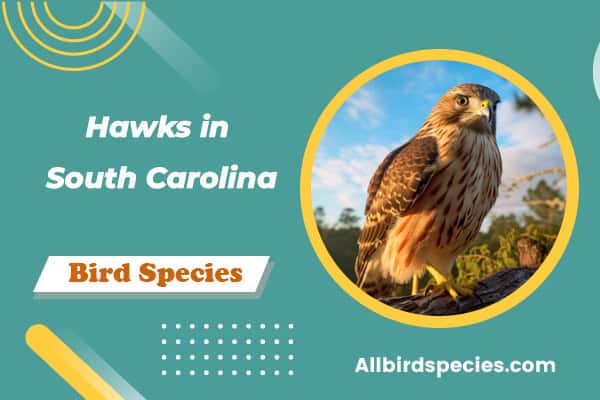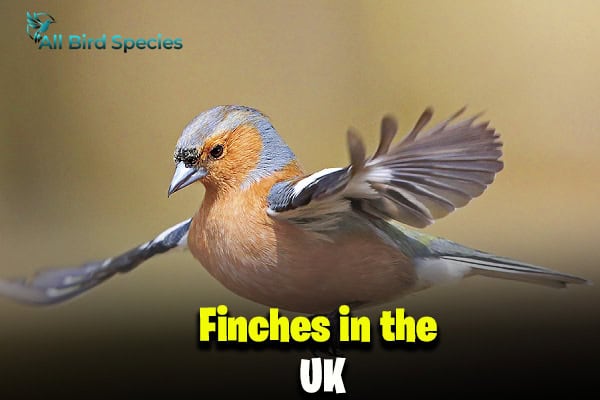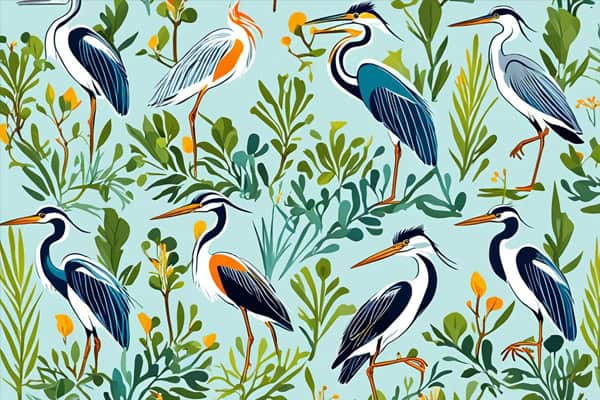2 Eagles in North Carolina (Pictures, ID Calls and Conservation)
Did you know that North Carolina is home to not just one, but two species of majestic eagles? That’s right! The state’s diverse landscapes provide the perfect habitat for both the iconic Bald Eagle and the elusive Golden EagleBald eagles, emblematic of strength and freedom, are a significant focus of bird conservation efforts aimed at protecting the habitats of bald eagles near large forest areas. in eastern North America. These magnificent birds of prey captivate our imagination with their impressive aerial maneuvers and awe-inspiring presence. Join us as we explore the incredible world of eagles in North Carolina and discover where these extraordinary creatures can be found.
Bald Eagle
- Scientific name: Haliaeetus leucocephalus
- Life span: 20-30 years
- Size: 2.5 to 3 feet (0.7 to 0.9 meters)
- Weight: 6.6 to 13,8 lbs (3 to 6.3 kg)
- Wingspan: 66 to 96 in (165 to 244 cm)
- Status: Least Concern
When it comes to eagle species, the Bald Eagle stands as a symbol of majesty and strength in North Carolina. With its striking white head and dark brown plumage, this magnificent bird is a sight to behold.

The Bald Eagle has long been a cherished part of North Carolina’s wildlife heritage, notably including the bald eagles found in North Carolina. Its significance is recognized by the state’s Wildlife Resources Commission, which has implemented various conservation efforts to protect and preserve eagle populations, particularly bald eagles in Eastern North, have seen fluctuations in numbers due to various conservation challenges. and their nesting sites.
Impressive Aerial Maneuvers
One of the most captivating aspects of the Bald Eagle is its ability to perform impressive aerial maneuvers. With a wingspan of bald eagles hold their wings in a distinctive manner while soar with a majestic ease, a behavior especially observed in bald eagles over eastern North American forests.ing. that can reach up to 7 feet, it gracefully soars through the sky, captivating onlookers with its powerful flight.
“The Bald Eagle’s aerial prowess is truly a marvel to witness. Its commanding presence and elegant movements make it a favorite among birdwatchers and nature enthusiasts.” – Wildlife Biologist
Whether it’s scanning the water for fish or navigating the currents with grace, the Bald Eagle’s aerial skills showcase its mastery of the sky.
Conservation Efforts and Protection
Recognizing the importance of preserving this iconic raptor, North Carolina has made significant efforts to protect and conserve the Bald Eagle. These efforts include safeguarding its nesting sites and ensuring the well-being of eagle populations throughout the state.
The Bald and Golden Eagle Protection Act, enacted by the U.S. government, provides legal protection for these majestic birds, prohibiting various activities that could harm them or disturb their habitats.
Must Read Cockatoos in Australia
Eagle Populations and Nesting Sites
Thanks to the conservation efforts and habitat preservation initiatives for birds, including those aiming to protect bald eagle nests. eagle populations in North Carolina have experienced a resurgence. As a result, the state is home to numerous nesting sites where these birds can thrive.
These nesting sites include large bodies of water, such as lakes and rivers, which provide ample food sources for the Bald Eagle. Cliffs and grasslands also offer suitable habitats for nesting and raising their young.
| Conservation Efforts | Impact |
|---|---|
| Protection and Conservation | Preservation of nesting sites and essential habitats for Bald Eagles |
| Wildlife Resources Commission | Implementation of conservation programs for eagle populations |
| Bald and Golden Eagle Protection Act | Legal protection against disturbance or harm to eagles and their habitats |
The Golden Eagle
- Scientific name: Aquila chrysaetos
- Life span: 30 years
- Size: 33 inches (83 cm)
- Weight: 6.4 to 13.2 lb (2.9 to 6 kg)
- Wingspan: 70 to 90 in (180 to 230 cm)
- Status: Least Concern
When it comes to magnificent birds of prey, the Golden Eagle truly stands out. Found in the western region of North Carolina, this elusive species captures the imagination of biologists and bird enthusiasts alike. With its dark brown plumage and impressive aerial maneuvers, the Golden Eagle is a sight to behold.

During the conservation efforts, a focus has been placed on securing bald eagle nests. winter months, the Golden Eagle finds solace in the scenic landscapes of Western North Carolina. However, habitat loss poses a significant challenge to the survival of this large raptor. Conservation efforts and awareness are crucial in protecting the Golden Eagle and preserving its place in the rich natural heritage of the state.
Let’s take a closer look at the distinctive features and behavior of this magnificent bird:
Distinctive Features
- Dark brown plumage
- Impressive aerial maneuvers
- Magnificent wingspan
- Strong and powerful build
Behavior and Habits
The Golden Eagle is known for its remarkable hunting skills, often spotted soaring through the sky in search of prey. With its keen eyesight and agile movements, this bird can capture small mammals and other birds with remarkable precision.
Despite its grandeur, the Golden Eagle faces threats due to habitat destruction near large forests. habitat loss. As urbanization and other human activities encroach on their natural habitats, it becomes increasingly important to protect these vulnerable species and preserve their role in maintaining the delicate ecosystem.
| Challenges Faced by the Golden Eagle | Conservation Solutions |
|---|---|
| Habitat loss | Preserving and restoring suitable habitats |
| Human disturbance | Establishing protected areas and educating the public |
| Illegal hunting | Enforcing strict wildlife protection laws |
By raising awareness about the importance of the Golden Eagle’s presence and advocating for its conservation, we can ensure that future generations will have the chance to witness the beauty and grace of this majestic bird soaring through the skies of Western North Carolina.
Must Explore Blue Bird With A Red or Orange Chest
Where to Find Eagles in North Carolina
If you’re an avid birdwatcher or simply have a fascination with eagles, North Carolina offers some excellent opportunities to observe these majestic birds in their natural habitat. Keep in mind that eagles can be found in various regions of the state, especially in areas with large bodies of water, cliffs, grasslands, and along large rivers.
Lake Mattamuskeet
Located in Hyde County, Lake Mattamuskeet is a prime spot to catch a glimpse of eagles. As the largest natural lake in North Carolina, this expansive body of water provides an ideal winter home for eagles. With its diverse ecosystem and abundant fish population, Lake Mattamuskeet attracts eagles seeking food and shelter during the colder months.
Unaka Mountain, a forested habitat crucial for the bald eagle populations found in eastern North.
If you’re in western North Carolina, Unaka Mountain is an excellent location to spot eagles. This majestic mountain range offers not only breathtaking views but also serves as a haven for eagles. The towering cliffs and vast wilderness provide a favorable habitat for these magnificent birds.
Alligator River
On the eastern coast of North Carolina, the Alligator River National Wildlife Refuge is a prime location to observe eagles. As the name suggests, this refuge is home to a rich diversity of wildlife, including eagles. With its extensive waterways and marshland, the Alligator River area provides an abundant food source and a sanctuary for eagles to thrive.
Remember that when observing eagles, it is important to maintain a respectful distance and not disturb their natural behavior. Binoculars or a spotting scope can be handy for a closer look while ensuring the birds are not disturbed.
Eagle Habits and Behaviors
Eagles are truly remarkable birds, known for their fascinating habits and behaviors. From their distinctive calls to their impressive soaring abilities, eagles capture our attention and awe. Let’s explore some of the key habits and behaviors that make eagles such fascinating creatures.
Eagle Calls and Communication
One of the most iconic features of eagles is their distinctive call, which often echoes through the skies. This call serves various purposes, including communication between mates, establishing territory, and signaling danger to other eagles. The eagle call is a powerful and evocative sound that evokes the wild and untamed spirit of these majestic birds.
Nesting Habits
When it comes to nesting, eagles are meticulous and dedicated. They build large nests in high and secure locations such as cliffs, tall trees, or man-made structures. These nests, known as eyries, are often reused year after year, with the eagles adding to them and maintaining their structural integrity. The construction and maintenance of nests contribute to the continuity of eagle populations.
Scavenging Behavior
While eagles are skilled hunters, they are also opportunistic scavengers. They have been observed feeding on carrion, taking advantage of available food sources when hunting is challenging. This scavenging behavior showcases their adaptability and resourcefulness in ensuring their survival.
Soaring the Skies
Eagles are renowned for their ability to soar high above the ground, utilizing thermals and updrafts to stay aloft for extended periods. Soaring allows eagles to conserve energy while surveying the landscape for potential prey or defending their territory. Watching an eagle effortlessly glide through the air is truly a sight to behold.
Feeding Habits
Fish make up a significant portion of an eagle’s diet, especially for species like the Bald Eagle. Eagles are skilled fishers, using their sharp talons to snatch fish from the water’s surface. They will also hunt for small mammals or birds when fish are scarce. Their feeding habits demonstrate their specialization as powerful raptors, perfectly adapted to their natural environment, including the bald eagles found in North Carolina forests.
Mate for Life
One of the remarkable aspects of eagle behavior is their lifelong monogamous relationships. Eagles mate for life, forming strong bonds that endure throughout the years. They work together in raising their young and maintaining their nesting territories. This commitment to their partners is a testament to the deep connection and loyalty that exists within eagle communities.
The Conservation of Eagles in North Carolina
Protecting and conserving eagle populations in North Carolina is a priority for us. Various efforts have been implemented to ensure the well-being and survival of these majestic birds. One of the significant challenges faced by eagle populations is the impact of DDT, a harmful pesticide that can adversely affect their reproductive abilities and overall health.
The Bald and Golden Eagle Protection Act, enacted in 1940, plays a vital role in safeguarding these birds from poaching, disturbance, and habitat destruction. Under this act, it is prohibited to harm, disturb, or possess eagle feathers or other parts without the necessary permits. This legislation reflects our commitment to the protection and conservation of these iconic bird species.
The U.S. Fish and Wildlife Service, along with other organizations and agencies, actively works to preserve and restore eagle habitats throughout North Carolina. By focusing on habitat conservation and restoration initiatives, we strive to provide ample nesting and foraging areas for eagles, mitigating the impacts of habitat loss.
We believe that knowledge and awareness are essential for effective conservation efforts. Educating the public about the importance of eagle habitats, their role in the ecosystem, and the conservation challenges they face is crucial to garnering support for their protection. Through community engagement and outreach programs, we aim to instill a sense of stewardship and responsibility towards eagles and their habitats.
Conservation Initiatives at a Glance:
| Initiative | Description |
|---|---|
| Monitoring and Research | Conducting extensive research to study eagle populations, their behavior, and the factors affecting their survival. |
| Habitat Restoration | Implementing restoration projects to enhance and protect eagle habitats, including suitable nesting sites and foraging grounds. |
| Partnerships and Collaboration | Working closely with landowners, conservation organizations, and other stakeholders to foster collaborative efforts in eagle conservation. |
| Public Education | Raising awareness about eagle conservation through educational programs, public events, and interpretive materials to inspire action and support. |
| Policy and Advocacy | Advocating for policies and regulations that prioritize eagle protection and promote responsible land and resource management practices. |
Together, we can ensure a future where eagles continue to soar across the North Carolina sky. By valuing and protecting their habitats, we contribute to the preservation of these magnificent birds for generations to come.
The Magnificence of Eagles: A Sight to Behold
When it comes to powerful raptors, few can match the majestic beauty of eagles. With their impressive wingspan and soaring flight, these birds command attention wherever they go. Eagles are known for their dark brown bodies and striking white head and tail feathers, which make them easy to spot in the sky.
One of the most remarkable aspects of eagles is their migratory nature. These magnificent creatures travel long distances during their annual migration, navigating across vast territories in search of food and suitable habitats. Their ability to cover such great distances showcases their strength and adaptability.
Young eagles are equally captivating with their bright white tail feathers, which contrast starkly with their dark brown body with a striking contrast to the “bald” white head, reminiscent of how the old English word “piebald” refers to a mottle or patchy coloring.. As they grow and mature, their plumage gradually changes to match that of their adult counterparts. This transformation is a testament to the beauty and grace that eagles possess.
Protecting North Carolina’s Eagles for Future Generations
Ensuring the protection and conservation of eagle populations is vital for the future of North Carolina’s majestic birds. These awe-inspiring creatures face numerous threats, including habitat loss, carrion contamination, and the impact of eggshell thinning. As avian wonders with their striking yellow beaks and brilliant white plumages, eagles play a crucial role in our ecosystem, making it essential for us to take action.
Habitat loss poses a significant challenge to eagle populations. As human activities encroach upon their natural habitats, eagles face a shrinking range and diminished resources. To safeguard their future, we must prioritize the preservation of their habitats by implementing conservation initiatives and land protection measures.
The effects of carrion contamination and eggshell thinning also pose a grave danger to eagles. Prolonged exposure to toxic substances can have debilitating effects on their health and reproduction. By raising awareness about the detrimental impacts of pollution and implementing measures to mitigate its effects, we can help ensure a safer environment for eagles to thrive.
It is our collective responsibility to safeguard these magnificent birds for future generations. Through education, advocacy, and active participation in conservation efforts, we can make a difference. By embracing the need for protection and conservation, we can secure a brighter future for North Carolina’s eagle populations, allowing these remarkable creatures to continue soaring through our skies for years to come.







